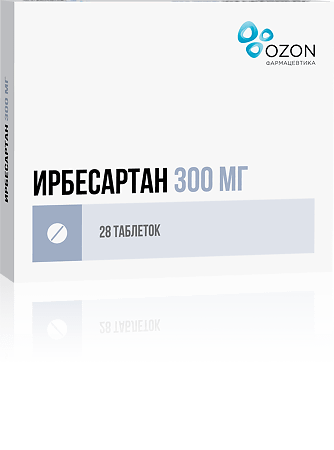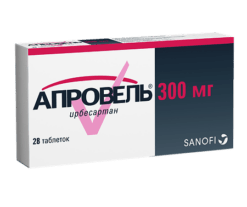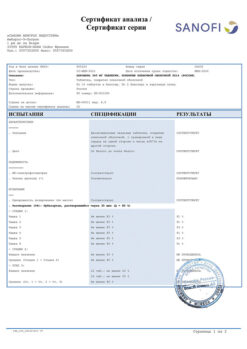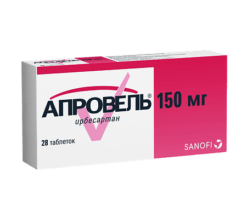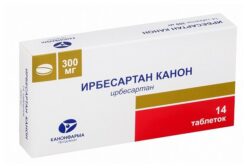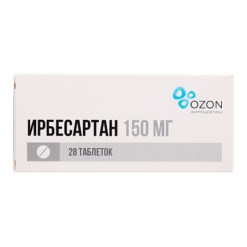No products in the cart.
Irbesartan, 300 mg 28 pcs
€18.78 €15.65
Description
Pharmacotherapeutic group
An angiotensin II receptor antagonist
ATX code
C09CA04
Pharmacodynamics:
Irbesartan is a selective angiotensin II receptor antagonist (type AT1). Reduces plasma aldosterone concentration (does not inhibit bradykinin-depleting kinase II); eliminates the vasoconstrictor effect of angiotensin II; reduces total peripheral vascular resistance reduces postload systemic arterial pressure (BP) and pressure in the “small” circulatory circle. It does not affect the concentration of triglycerides cholesterol glucose uric acid in plasma and uric acid excretion.
The maximum BP reduction is achieved 3-6 h after oral administration and the antihypertensive effect is maintained for at least 24 h. Twenty-four hours after ingestion at recommended doses, the BP reduction is 60-70% compared to the maximum diastolic and systolic BP reduction in response to drug administration. When administered once daily in a dose of 150-300 mg, the degree of BP reduction (systolic/diastolic) at the end of the interdose interval (i.e. 24 hours after drug administration) in patient lying or sitting position is on average 8-13/5-8 mmHg (respectively) greater compared to placebo. The administration of 150 mg once daily causes the same antihypertensive response (decrease of BP before the next dose and the average BP decrease within 24 hours) as the administration of the same dose divided into 2 doses. The antihypertensive effect of irbesartan develops within 1-2 weeks, and the maximum therapeutic effect is achieved 4-6 weeks after the start of treatment. The antihypertensive effect is maintained during long-term treatment. After discontinuation of treatment, BP gradually returns to the initial value of “withdrawal” syndrome was not observed.
The efficacy of the drug is independent of age and sex.
Patients of non-hyrogenic race respond less well to irbesartan monotherapy (as to all other drugs affecting the renin-angiotensin-aldosterone system (RAAS)). Pharmacokinetics:
Intake
After oral administration, irbesartan is well absorbed from the gastrointestinal tract (GIT). Maximal concentration (Cmax) of irbesartan in blood plasma is reached 15-2 hours after oral administration. Absolute bioavailability is 60-80%. Concomitant intake of food does not significantly affect the bioavailability of the drug. Irbesartan has linear and dose-proportional pharmacokinetics in the dosage range from 10 to 600 mg; at doses greater than 600 mg (2-fold higher than the recommended maximum dose) kinetics of irbesartan becomes non-linear (decrease of absorption).
Distribution
The binding to plasma proteins is approximately 96%. Binding to cellular components of the blood is insignificant. The volume of distribution is 53-93 liters. With daily administration once a day the equilibrium concentration is reached after 3 days. Limited accumulation of irbesartan in blood plasma (less than 20%) is observed after repeated dosing once daily. After oral administration or intravenous administration of 14C-irbesartan 80-85% of radioactivity in circulating blood is due to unchanged irbesartan.
Metabolism
Irbesartan is biotransformed in the liver by oxidation and conjugation to glucuronic acid.
Irbesartan is oxidized primarily by the CYP2C9 isoenzyme. The CYP3A4 isoenzyme is not significantly involved in the metabolism of irbesartan. The main metabolite in the systemic blood stream is irbesartan glucuronide (about 6%). Irbesartan is not metabolized by most isoenzymes that are usually involved in metabolism of drugs (CYP1A1 CYP1A2 CYP2A6 CYP2B6 CYP2D6 or CYP2E1 isoenzymes) and does not cause their inhibition or induction. Irbesartan does not induce or inhibit the CYP3A4 isoenzyme.
Elimination
Total clearance and renal clearance are 157-176 ml/min and 3-3.5 ml/min, respectively. The final elimination half-life (T1/2) is 11-15 h. Irbesartan and its metabolites are excreted by the kidneys through the intestine with the bile. After oral administration of 14C-irbesartan about 20% of radioactivity is found in urine and the rest – in feces.
Less than 2% of the administered dose is excreted by the kidneys as unchanged irbesartan.
Special patient groups
The effect of sex on the pharmacokinetics of irbesartan
Slightly higher plasma concentrations of irbesartan have been observed in women (compared to men). However, no differences in the T1/2 value and accumulation of irbesartan were found. No dose adjustment of irbesartan in women is required.
There were no gender-related differences in the effects of irbesartan.
Pharmacokinetics of irbesartan in elderly patients
The AUC (area under the concentration-time curve) and Stath values of irbesartan were slightly higher in elderly patients (over 65 years) than in younger patients but the final T1/2 were not significantly different. No dose adjustment of irbesartan is required in elderly patients.
Pharmacokinetics in renal impairment
In patients with impaired renal function or patients undergoing hemodialysis, the pharmacokinetics of irbesartan are not significantly altered. Irbesartan is not eliminated from the body by hemodialysis.
Pharmacokinetics in hepatic impairment
In patients with mild (Child-Pugh score 5-6) or moderate (Child-Pugh score 7-9) cirrhosis, the pharmacokinetic parameters of irbesartan are not significantly altered. No pharmacokinetic studies have been performed in patients with severe (greater than 9 points on the Child-Pugh scale) hepatic impairment.
The effect of race on the pharmacokinetics of irbesartan
The AUC and T1/2 of irbesartan were approximately 20-25% higher in black volunteers without arterial hypertension than in those of the Caucasian race; their Cmax of irbesartan was virtually the same as that of the Caucasian race.
Indications
Indications
– Arterial hypertension (in monotherapy and in combination with other antihypertensive drugs, such as thiazide diuretics, beta-blockers, long-acting slow calcium channel blockers (SCBCs);
– nephropathy in arterial hypertension and type 2 diabetes mellitus (as part of combination antihypertensive therapy).
Pharmacological effect
Pharmacological effect
Pharmacotherapeutic group
Angiotensin II receptor antagonist
ATX code
C09CA04
Pharmacodynamics:
Irbesartan is a selective antagonist of angiotensin II receptors (AT1 type). Reduces the concentration of aldosterone in the blood plasma (does not suppress kinase II that destroys bradykinin); eliminates the vasoconstrictor effect of angiotensin II; reduces total peripheral vascular resistance, reduces afterload, systemic blood pressure (BP) and pressure in the “lesser” circulation. Does not affect the concentration of triglycerides cholesterol glucose uric acid in plasma and the excretion of uric acid.
The maximum reduction in blood pressure is achieved 3-6 hours after taking the drug orally and the antihypertensive effect persists for at least 24 hours. 24 hours after taking the recommended doses, the decrease in blood pressure is 60-70% compared to the maximum decrease in diastolic and systolic blood pressure in response to the drug. When taken once a day at a dose of 150-300 mg, the degree of reduction in blood pressure (systolic/diastolic) at the end of the interdose interval (i.e., 24 hours after taking the drug) with the patient lying or sitting by an average of 8-13/5-8 mm Hg. (respectively) more compared to placebo. Taking the drug at a dose of 150 mg 1 time/day causes the same antihypertensive response (decrease in blood pressure before taking the next dose of the drug and the average decrease in blood pressure over 24 hours) as taking the same dose divided into 2 doses. The antihypertensive effect of irbesartan develops within 1-2 weeks and the maximum therapeutic effect is achieved 4-6 weeks after the start of treatment. The antihypertensive effect persists during long-term treatment. After cessation of treatment, blood pressure gradually returns to the original value; no withdrawal syndrome was observed.
The effectiveness of the drug does not depend on age and gender.
Patients of the Negroid race respond less poorly to monotherapy with irbesartan (as well as to all other drugs affecting the renin-angiotensin-aldosterone system (RAAS)).
Pharmacokinetics:
Suction
After oral administration, irbesartan is well absorbed from the gastrointestinal tract (GIT). The maximum concentration (Cmax) of irbesartan in the blood plasma is achieved 15-2 hours after oral administration. Absolute bioavailability is 60-80%. Concomitant food intake does not significantly affect the bioavailability of the drug. Irbesartan has linear and dose-proportional pharmacokinetics in the dose range from 10 to 600 mg; at doses above 600 mg (2 times the recommended maximum dose), the kinetics of irbesartan becomes nonlinear (decreased absorption).
Distribution
Plasma protein binding is approximately 96%. Binding to cellular components of blood is negligible. Distribution volume – 53-93 l. When taken daily 1 time/day, equilibrium concentration is achieved after 3 days. With repeated doses 1 time/day, limited accumulation of irbesartan in the blood plasma is observed (less than 20%). After oral or intravenous administration of 14C-irbesargan, 80-85% of the radioactivity in the circulating blood is unchanged irbesartan.
Metabolism
Irbesartan is biotransformed in the liver by oxidation and conjugation with glucuronic acid.
Irbesartan is oxidized mainly by the CYP2C9 isoenzyme; the participation of the CYP3A4 isoenzyme in the metabolism of irbesartan is insignificant. The main metabolite found in the systemic circulation is irbesartan glucuronide (about 6%). Irbesartan is not metabolized by most isoenzymes that are usually involved in the metabolism of drugs (isoenzymes CYP1A1 CYP1A2 CYP2A6 CYP2B6 CYP2D6 or CYP2E1) and does not cause their inhibition or induction. Irbesartan does not induce or inhibit the CYP3A4 isoenzyme.
Removal
Total clearance and renal clearance are 157-176 ml/min and 3-3.5 ml/min, respectively. The final half-life (T1/2) is 11-15 hours. Irbesartan and its metabolites are excreted by the kidneys through the intestines with bile. After ingestion of 14C-irbesartan, about 20% of the radioactivity is found in the urine, the rest in the feces.
Less than 2% of the administered dose is excreted by the kidneys as unchanged irbesartan.
Special patient groups
Effect of gender on the pharmacokinetics of irbesartan
Slightly higher plasma concentrations of irbesartan are observed in women (compared to men). However, differences in the T1/2 value and accumulation of irbesartan were not detected. No dose adjustment of irbesartan is required in women.
There were no gender-related differences in the effects of irbesartan.
Pharmacokinetics of irbesartan in elderly patients
The AUC (area under the concentration-time curve) and Cmax values of irbesartan were slightly higher in elderly patients (over 65 years of age) than in younger patients, but the final T1/2 values did not differ significantly. No dose adjustment of irbesartan is required in elderly patients.
Pharmacokinetics in renal impairment
In patients with impaired renal function or patients undergoing hemodialysis, the pharmacokinetics of irbesartan do not change significantly. Irbesartan is not removed from the body by hemodialysis.
Pharmacokinetics in liver dysfunction
In patients with mild (5-6 points on the Child-Pugh scale) or moderately severe liver cirrhosis (7-9 points on the Child-Pugh scale), the pharmacokinetic parameters of irbesartan do not change significantly. Pharmacokinetic studies have not been conducted in patients with severe (more than 9 points on the Child-Pugh scale) liver failure.
The influence of race on the pharmacokinetics of irbesartan
In black volunteers without arterial hypertension, AUC and T1/2 of irbesartan were approximately 20-25% higher than in representatives of the Caucasian race; C maxirbesartan in them was almost the same as that in representatives of the Caucasian race.
Special instructions
Special instructions
Excessive decrease in blood pressure – patients with hypovolemia
To date, the use of the drug irbesartan has rarely been accompanied by an excessive decrease in blood pressure in patients with arterial hypertension without concomitant diseases. As with the use of ACE inhibitors, an excessive decrease in blood pressure accompanied by clinical symptoms can develop in patients with hyponatremia/hypovolemia (for example, as a result of intensive diuretic therapy for diarrhea or vomiting, following a diet with limited salt intake) as well as in patients on hemodialysis. Before starting the use of Irbesartan, it is necessary to correct hypovolemia and/or hyponatremia.
Use in patients with renal function dependent on RAAS activity
As a consequence of RAAS inhibition, deterioration of renal function can be expected in predisposed patients. In patients with renal function dependent on the activity of the RAAS (patients with arterial hypertension and renal artery stenosis of one or both kidneys, patients with chronic heart failure of NYHA functional class III and IV), treatment with drugs that affect the RAAS has been associated with oliguria and/or progressive azotemia and rarely with acute renal failure and/or death. The possibility of a similar effect occurring when using ARA II including irbesartan cannot be excluded.
Renal dysfunction and kidney transplantation
When using the drug Irbesartan in patients with impaired renal function, periodic monitoring of potassium levels and creatinine concentrations in the blood serum is recommended. There are no clinical data regarding the use of irbesartan in patients who have recently undergone a kidney transplant.
Patients with arterial hypertension and type 2 diabetes mellitus with impaired renal function
The beneficial effect of irbesartan in slowing the progression of renal and cardiovascular disorders had varying degrees of severity in different groups of patients; it was less pronounced in women and in non-Caucasian patients.
Dual blockade of the RAAS when used with ACE inhibitors or aliskiren
Double blockade of the RAAS with simultaneous use of irbesartan with ACE inhibitors or aliskiren is not recommended since, compared with monotherapy, there is an increased risk of a sharp decrease in blood pressure, the development of hyperkalemia and impaired renal function.
The use of Irbesartan in combination with aliskiren is contraindicated in patients with diabetes mellitus or renal failure (GFR less than 60 ml/min/173 m2 body surface area) (see sections “Contraindications” “Interaction with other drugs”) and is not recommended in other patients.
The use of Irbesartan in combination with ACE inhibitors is contraindicated in patients with diabetic nephropathy (see sections “Contraindications” “Interaction with other drugs”) and is not recommended in other patients.
Hyperkalemia
As with the use of other drugs that affect the RAAS, hyperkalemia may develop during therapy with Irbesartan, especially in the presence of renal failure and/or heart disease. In such patients, it is recommended to monitor serum potassium levels.
Aortic or mitral valve stenosis hypertrophic obstructive cardiomyopathy
As with the use of other vasodilators, caution should be exercised when taking Irbesartan in patients with aortic or mitral stenosis or hypertrophic obstructive cardiomyopathy.
Primary hyperaldosteronism
Patients with primary hyperaldosteronism usually do not respond to antihypertensive drugs that act by inhibiting the RAAS. Therefore, the use of the drug in such cases is inappropriate.
Patients with coronary heart disease and/or clinically significant cerebral atherosclerosis
As with the use of other antihypertensive drugs, a significant decrease in blood pressure in patients with coronary heart disease and/or severe cerebral atherosclerosis can lead to the development of myocardial infarction or stroke. Treatment of such patients should be carried out under strict blood pressure control.
Impact on the ability to drive vehicles. Wed and fur.:
The effect of Irbesartan on the ability to drive vehicles or engage in other potentially hazardous activities requiring increased attention and high speed of psychomotor reactions has not been studied. However, based on the pharmacodynamic properties of the drug Irbesartan should not affect the ability to drive vehicles and engage in other potentially hazardous activities (work at height, work as an air traffic controller, work with machinery, etc.), but in case of dizziness and weakness, a decrease in psychomotor reactions is possible, so it is better to refrain from this type of activity.
Active ingredient
Active ingredient
Irbesartan
Composition
Composition
Active ingredient:
irbesartan – 300.00 mg.
Excipients (core):
lactose monohydrate (milk sugar) – 186.40 mg,
microcrystalline cellulose – 96.00 mg,
croscarmellose sodium – 28.80 mg,
povidone-K25 – 19.20 mg,
magnesium stearate – 6.40 mg,
colloidal silicon dioxide – 3.20 mg.
Excipients (shell): hypromellose – 8.80 mg, macrogol-4000 – 2.40 mg, titanium dioxide – 4.80 mg.
Pregnancy
Pregnancy
There is no experience with the use of Irbesartan during pregnancy. Taking into account the fact that when pregnant women took ACE inhibitors in the second and third trimester of pregnancy, damage and death of the developing fetus were observed, irbesartan, like any other drug that directly affects the RAAS, cannot be used during pregnancy. If pregnancy is established during treatment with Irbesartan, you should stop taking it as soon as possible.
It is unknown whether irbesartan and its metabolites are excreted in breast milk. During breastfeeding, taking Irbesartan is contraindicated. Therefore, after assessing the ratio of the expected benefit of taking the drug for the mother and the potential risk for the child, breastfeeding or taking Irbesartan should be stopped.
Contraindications
Contraindications
– Hypersensitivity to irbesartan and to any of the auxiliary components of the drug;
– pregnancy;
– breastfeeding period;
– children and adolescents under 18 years of age (efficacy and safety have not been established);
– galactose intolerance, lactase deficiency and glucose-galactose malabsorption syndrome;
– simultaneous use with aliskiren and aliskiren-containing drugs in patients with diabetes mellitus or with moderate to severe renal failure (glomerular filtration rate (GFR) less than 60 ml/min/173 m2 body surface area).
– simultaneous use with angiotensin-converting enzyme (ACE) inhibitors in patients with diabetic nephropathy.
– severe liver failure (more than 9 points on the Child-Pugh scale) (lack of clinical experience with use).
With caution:
The drug should be used with caution in case of aortic or mitral valve stenosis, hypertrophic obstructive cardiomyopathy, hypovolemia, hyponatremia, diarrhea, vomiting, following a diet with limited salt intake, diuretic therapy; bilateral stenosis of the renal arteries unilateral stenosis of the artery of a single kidney chronic heart failure III-IV functional class according to the NYHA classification coronary heart disease (CHD) and/or atherosclerotic lesions of cerebral vessels hyperkalemia renal failure hemodialysis after kidney transplantation (lack of clinical experience of use) age over 75 years; when used simultaneously with non-steroidal anti-inflammatory drugs including cyclooxygenase II inhibitors; when used in combination with ACE inhibitors or aliskiren since, compared with monotherapy with double blockade of the RAAS, there is an increased risk of developing an excessive decrease in blood pressure, hyperkalemia and impaired renal function; primary hyperaldosteronism.
Side Effects
Side Effects
The following adverse events are presented in accordance with the following gradations of the frequency of their occurrence (according to the World Health Organization classification): very often (≥1/10) often (≥1/100 – <1/10) infrequently (≥1/1,000 - <1/100) rarely (≥1/10,000 - <1/1,000) very rarely (<1/10 000) frequency unknown (estimate cannot be made from available data).
Adverse events observed in placebo-controlled studies in hypertension
From the central nervous system: often – dizziness, headache; infrequently – orthostatic dizziness.
From the cardiovascular system: infrequently – edema, tachycardia.
From the respiratory system: infrequently – cough.
From the digestive system: often – nausea, vomiting; infrequently – diarrhea, dyspepsia, heartburn.
From the reproductive system: infrequently – sexual dysfunction.
From the body as a whole: often – increased fatigue; infrequently – chest pain.
From the laboratory parameters: during the studies, no clinically significant changes in laboratory parameters were observed in patients with arterial hypertension.
Arterial hypertension and type 2 diabetes mellitus with renal impairment
Adverse events were similar to those in patients with hypertension with the exception of orthostatic symptoms (dizziness (102%) (placebo 6%), orthostatic dizziness (54%) (placebo 27%) and orthostatic hypotension (54%) (placebo 32%).
Hyperkalemia
In the IDNT clinical trial, the percentage of patients with hyperkalemia (more than 6 mEq/L) was 186% in the irbesartan group versus 60% in the placebo group. In the IRMA2 study, the percentage of patients with hyperkalemia (more than 6 mEq/L) was 1% in the irbesartan group and no hyperkalemia was observed in the placebo group.
In the IDNT clinical trial, treatment discontinuation rates due to hyperkalemia with irbesartan and placebo were 21% and 036%, respectively. In the IRMA2 clinical trial, the discontinuation rate due to hyperkalemia with irbesartan and placebo was 05% and 00%, respectively.
Adverse events observed during post-marketing use of irbesartan
From the immune system: very rarely – allergic reactions (urticaria, angioedema).
Metabolism and nutrition: frequency unknown – hyperkalemia.
From the nervous system: frequency unknown – vertigo.
From the liver: frequency unknown – increased activity of liver enzymes and bilirubin concentration in the blood, hepatitis, jaundice.
On the part of the hearing organ: frequency unknown – ringing in the ears.
From the musculoskeletal system: frequency unknown – myalgia.
From the kidneys and urinary system: frequency unknown – impaired renal function, including the development of renal failure in patients at risk (see section “Special Instructions”).
General disorders: frequency unknown – asthenia.
Interaction
Interaction
With medicinal products containing aliskiren
The simultaneous use of irbesartan with drugs containing aliskiren is contraindicated in patients with diabetes mellitus or with moderate to severe renal failure (GFR less than 60 ml/min/173 m2 body surface area) and is not recommended in other patients (see sections “Contraindications” “With caution” “Special instructions”).
With ACE inhibitors
The use of irbesartan in combination with ACE inhibitors is contraindicated in patients with diabetic nephropathy and is not recommended in other patients (see sections “Contraindications” “With caution” “Special instructions”).
Diuretics and other antihypertensive drugs
With simultaneous use of irbesartan with other antihypertensive drugs, the antihypertensive effect may be enhanced. Irbesartan has been used in combination with other antihypertensive drugs such as long-acting β-blockers BMCC and thiazide diuretics.
Previous treatment with diuretics in high doses may lead to dehydration and an increased risk of arterial hypotension at the beginning of treatment with Irbesartan.
Potassium supplements and potassium-sparing diuretics heparin
Based on the experience gained with the use of other drugs that affect the RAAS, with the simultaneous use of potassium preparations, water-electrolyte solutions containing potassium, potassium-sparing diuretics or other drugs that can increase the level of potassium in the blood, incl. heparin may increase the potassium content in the blood serum.
Lithium
A reversible increase in serum lithium concentrations or toxicity has been observed with concomitant use of lithium with ACE inhibitors. To date, such effects have been observed extremely rarely with the use of irbesartan.
If there is a need to use this combination, the concentration of lithium in the blood serum should be carefully monitored during treatment.
Nonsteroidal anti-inflammatory drugs (NSAIDs including cyclooxygenase-2 (COX-2) inhibitors)
With the simultaneous use of angiotensin II receptor antagonists (ARA II) and NSAIDs (including selective COX-2 inhibitors acetylsalicylic acid (more than 3 g / day) and non-selective NSAIDs), the antihypertensive effect of irbesartan may be weakened.
As with the simultaneous use of ACE inhibitors and NSAIDs, the combined use of ARB II and NSAIDs may increase the risk of renal dysfunction, including the possibility of acute renal failure and an increase in serum potassium levels, especially in patients with already impaired renal function. This combination should be used with caution, especially in elderly patients and in patients with hypovolemia. It is necessary to restore the volume of circulating blood and monitor renal function throughout the entire period of combination therapy, as well as periodically after its completion.
Other types of interaction
Based on these in vitro studies, no interaction of irbesartan is expected with drugs metabolized by the isoenzymes CYP1A1 CYP1A2 CYP1A6 CYP2B6 CYP2E1 or CYP3A4.
Irbesartan is mainly metabolized with the participation of the CYP2C9 isoenzyme and is subject to glucuronidation to a lesser extent. No significant pharmacokinetic or pharmacodynamic interactions were observed when irbesartan was used concomitantly with warfarin with drugs metabolized by the CYP2C9 isoenzyme. The effect of inducers of CYP2C9 isoenzyme activity (including rifampicin) on the pharmacokinetics of irbesartan has not been studied.
Irbesartan does not change the pharmacokinetics of digoxin and simvastatin. With simultaneous use of irbesartan with hydrochlorothiazide or nifedipine, the pharmacokinetics of irbesartan does not change.
In elderly patients and patients with impaired renal function, concomitant use of ACE inhibitors and ARB II with sulfamethoxazole/trimethoprim was accompanied by severe hyperkalemia, which is believed to be caused by trimethoprim. The drug should be used with caution with drugs containing trimethoprim, regularly monitoring the potassium level in the blood.
Overdose
Overdose
Symptoms: most likely a pronounced decrease in blood pressure. tachycardia bradycardia.
Treatment: in case of accidental use of the drug in high doses, artificial vomiting and/or gastric lavage, activated charcoal and symptomatic and supportive therapy are indicated. Hemodialysis is ineffective.
Storage conditions
Storage conditions
At a temperature not exceeding 25 °C.
Keep out of the reach of children.
Shelf life
Shelf life
3 years.
Do not use after expiration date.
Manufacturer
Manufacturer
Ozon, Russia
Additional information
| Shelf life | 3 years. Do not use after the expiration date. |
|---|---|
| Conditions of storage | At a temperature not exceeding 25 ° C. Keep out of reach of children. |
| Manufacturer | Ozon, Russia |
| Medication form | pills |
| Brand | Ozon |
Other forms…
Related products
Buy Irbesartan, 300 mg 28 pcs with delivery to USA, UK, Europe and over 120 other countries.

